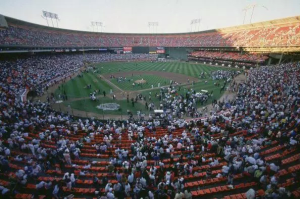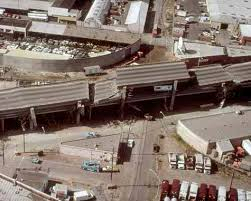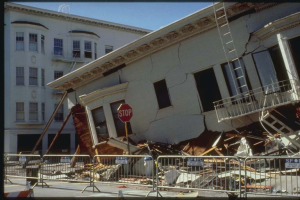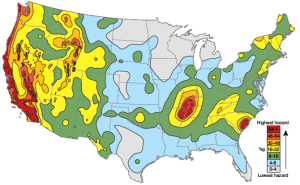“We could have had a real catastrophe here!”

So exclaimed a freshly frazzled Will Clark, first baseman for the San Francisco Giants, in his distinctive Lousiana drawl about an hour after the 1989 San Francisco earthquake. Called the “World Series Quake,” the 6.9 magnitude quake
happened on live television before millions of national viewers as the San Francisco Giants and Oakland A’s were warming up for Game 3 in Candlestick Park. Clark was noting that among the 50,000 fans, concessionaires, staff, umpires, two teams and their entourages, no one was killed—not even seriously injured.
The rest of the Bay Area did not fare as well. The 15 second quake (formally called the La Prieta Earthquake after its epicenter 60 miles south of San Francisco) caused over $7 billion in damage and claimed over 60 lives.

October 17
th will mark the 26
th anniversary of the infamous event, yet the images can be vividly recalled in the minds of those who were there, or viewed the extraordinary live news reports. Images like the Oakland Bay Bridge collapse, where the top westbound lanes fell onto the lower eastbound lanes, killing one driver. Much worse was the mile-and-a-quarter-long section of the elevated Nimitz Freeway that likewise collapsed. Forty-two died there. The rubble of burning homes in the Marina District, live television going black, people in offices, malls, and city streets going from complete calm to total panic in seconds—it’s all too easy to recall.

In the aftermath of the La Prieta quake, a long list of emergency protocols and civil ordinances were enacted to help guard against the next big shake-up. Community alert systems, including tsunami warning “amber alerts,” are a growing part of the Bay Area culture. Parking garages, apartment buildings and masonry construction standards have all been stiffened to do the same for these types of structures. Whole sections of the Bay Bridge and adjoining freeways have been renovated, or entirely replaced, as well.
But such precautions will have relatively small benefit when the next one hits if individual households neglect preparing in simple, yet essential ways. In a History Channel video short, James Dalessandro, author and 1906 San Francisco earthquake expert,
boldly asserts that the city, as a whole, is not ready.
“One of the greatest problems is the apathy of the people in San Francisco and Northern California,” Dalessandro asserts. “Probably 99% don’t have water supply and a food supply. It could be a week or more before anybody could possibly get to you.” He further advises, “The more self reliant, the more prepared you are, the greater your chances of survival.”
Of particular note, in news footage video, a San Francisco Police Officer is seen standing in the street directing emergency efforts at a crumbled row of formerly elegant and expensive homes. Yelling to the crowd of people with nowhere to go, he directs them to fill their bathtubs, collect canned foods, and know that it will be “at least 72-hours before help will arrive.”

The entire western third of the US is seconds away from a similar scene, as well as most the states of Alaska and Hawaii. Every citizen of large western cities know first-hand the feel of a mild rumble. A section of the Mississippi Valley called New Madrid is also highly prone to the occasional shake. And over the last 5 years, believe it or not, Oklahoma has evolved into the most earthquake-prone state in the country. With every occasional little tremor, everyone is asking themselves…”Is this it?”

The irony in all this is that, despite the broad knowledge of the impending danger, few living in these regions are ready…or even know how to get that way. Perhaps it’s time to change all that.
At the 25
th anniversary of the World Series Earthquake, the San Francisco Examiner asked Will Clark about that historic day at the ballpark.
“Oh my goodness, that was pretty traumatic,” he remembers. “Any disaster like this, everybody's affected in some way," Clark said. "You know somebody, or a friend's friend. It kind of sits with you, and you take it with you wherever you go."
You can be sure, among the millions affected that October evening in 1989, getting ready for the “Big One” is a daily thought. Hopefully, for their sakes, it’s also a deliberate action.
 a Rafflecopter giveaway
a Rafflecopter giveaway
 So exclaimed a freshly frazzled Will Clark, first baseman for the San Francisco Giants, in his distinctive Lousiana drawl about an hour after the 1989 San Francisco earthquake. Called the “World Series Quake,” the 6.9 magnitude quake happened on live television before millions of national viewers as the San Francisco Giants and Oakland A’s were warming up for Game 3 in Candlestick Park. Clark was noting that among the 50,000 fans, concessionaires, staff, umpires, two teams and their entourages, no one was killed—not even seriously injured.
The rest of the Bay Area did not fare as well. The 15 second quake (formally called the La Prieta Earthquake after its epicenter 60 miles south of San Francisco) caused over $7 billion in damage and claimed over 60 lives.
So exclaimed a freshly frazzled Will Clark, first baseman for the San Francisco Giants, in his distinctive Lousiana drawl about an hour after the 1989 San Francisco earthquake. Called the “World Series Quake,” the 6.9 magnitude quake happened on live television before millions of national viewers as the San Francisco Giants and Oakland A’s were warming up for Game 3 in Candlestick Park. Clark was noting that among the 50,000 fans, concessionaires, staff, umpires, two teams and their entourages, no one was killed—not even seriously injured.
The rest of the Bay Area did not fare as well. The 15 second quake (formally called the La Prieta Earthquake after its epicenter 60 miles south of San Francisco) caused over $7 billion in damage and claimed over 60 lives.
 October 17th will mark the 26th anniversary of the infamous event, yet the images can be vividly recalled in the minds of those who were there, or viewed the extraordinary live news reports. Images like the Oakland Bay Bridge collapse, where the top westbound lanes fell onto the lower eastbound lanes, killing one driver. Much worse was the mile-and-a-quarter-long section of the elevated Nimitz Freeway that likewise collapsed. Forty-two died there. The rubble of burning homes in the Marina District, live television going black, people in offices, malls, and city streets going from complete calm to total panic in seconds—it’s all too easy to recall.
October 17th will mark the 26th anniversary of the infamous event, yet the images can be vividly recalled in the minds of those who were there, or viewed the extraordinary live news reports. Images like the Oakland Bay Bridge collapse, where the top westbound lanes fell onto the lower eastbound lanes, killing one driver. Much worse was the mile-and-a-quarter-long section of the elevated Nimitz Freeway that likewise collapsed. Forty-two died there. The rubble of burning homes in the Marina District, live television going black, people in offices, malls, and city streets going from complete calm to total panic in seconds—it’s all too easy to recall.
 In the aftermath of the La Prieta quake, a long list of emergency protocols and civil ordinances were enacted to help guard against the next big shake-up. Community alert systems, including tsunami warning “amber alerts,” are a growing part of the Bay Area culture. Parking garages, apartment buildings and masonry construction standards have all been stiffened to do the same for these types of structures. Whole sections of the Bay Bridge and adjoining freeways have been renovated, or entirely replaced, as well.
But such precautions will have relatively small benefit when the next one hits if individual households neglect preparing in simple, yet essential ways. In a History Channel video short, James Dalessandro, author and 1906 San Francisco earthquake expert, boldly asserts that the city, as a whole, is not ready.
“One of the greatest problems is the apathy of the people in San Francisco and Northern California,” Dalessandro asserts. “Probably 99% don’t have water supply and a food supply. It could be a week or more before anybody could possibly get to you.” He further advises, “The more self reliant, the more prepared you are, the greater your chances of survival.”
Of particular note, in news footage video, a San Francisco Police Officer is seen standing in the street directing emergency efforts at a crumbled row of formerly elegant and expensive homes. Yelling to the crowd of people with nowhere to go, he directs them to fill their bathtubs, collect canned foods, and know that it will be “at least 72-hours before help will arrive.”
In the aftermath of the La Prieta quake, a long list of emergency protocols and civil ordinances were enacted to help guard against the next big shake-up. Community alert systems, including tsunami warning “amber alerts,” are a growing part of the Bay Area culture. Parking garages, apartment buildings and masonry construction standards have all been stiffened to do the same for these types of structures. Whole sections of the Bay Bridge and adjoining freeways have been renovated, or entirely replaced, as well.
But such precautions will have relatively small benefit when the next one hits if individual households neglect preparing in simple, yet essential ways. In a History Channel video short, James Dalessandro, author and 1906 San Francisco earthquake expert, boldly asserts that the city, as a whole, is not ready.
“One of the greatest problems is the apathy of the people in San Francisco and Northern California,” Dalessandro asserts. “Probably 99% don’t have water supply and a food supply. It could be a week or more before anybody could possibly get to you.” He further advises, “The more self reliant, the more prepared you are, the greater your chances of survival.”
Of particular note, in news footage video, a San Francisco Police Officer is seen standing in the street directing emergency efforts at a crumbled row of formerly elegant and expensive homes. Yelling to the crowd of people with nowhere to go, he directs them to fill their bathtubs, collect canned foods, and know that it will be “at least 72-hours before help will arrive.”
 The entire western third of the US is seconds away from a similar scene, as well as most the states of Alaska and Hawaii. Every citizen of large western cities know first-hand the feel of a mild rumble. A section of the Mississippi Valley called New Madrid is also highly prone to the occasional shake. And over the last 5 years, believe it or not, Oklahoma has evolved into the most earthquake-prone state in the country. With every occasional little tremor, everyone is asking themselves…”Is this it?”
The entire western third of the US is seconds away from a similar scene, as well as most the states of Alaska and Hawaii. Every citizen of large western cities know first-hand the feel of a mild rumble. A section of the Mississippi Valley called New Madrid is also highly prone to the occasional shake. And over the last 5 years, believe it or not, Oklahoma has evolved into the most earthquake-prone state in the country. With every occasional little tremor, everyone is asking themselves…”Is this it?”
 The irony in all this is that, despite the broad knowledge of the impending danger, few living in these regions are ready…or even know how to get that way. Perhaps it’s time to change all that.
At the 25th anniversary of the World Series Earthquake, the San Francisco Examiner asked Will Clark about that historic day at the ballpark.
“Oh my goodness, that was pretty traumatic,” he remembers. “Any disaster like this, everybody's affected in some way," Clark said. "You know somebody, or a friend's friend. It kind of sits with you, and you take it with you wherever you go."
You can be sure, among the millions affected that October evening in 1989, getting ready for the “Big One” is a daily thought. Hopefully, for their sakes, it’s also a deliberate action.
The irony in all this is that, despite the broad knowledge of the impending danger, few living in these regions are ready…or even know how to get that way. Perhaps it’s time to change all that.
At the 25th anniversary of the World Series Earthquake, the San Francisco Examiner asked Will Clark about that historic day at the ballpark.
“Oh my goodness, that was pretty traumatic,” he remembers. “Any disaster like this, everybody's affected in some way," Clark said. "You know somebody, or a friend's friend. It kind of sits with you, and you take it with you wherever you go."
You can be sure, among the millions affected that October evening in 1989, getting ready for the “Big One” is a daily thought. Hopefully, for their sakes, it’s also a deliberate action.
 a Rafflecopter giveaway
a Rafflecopter giveaway

